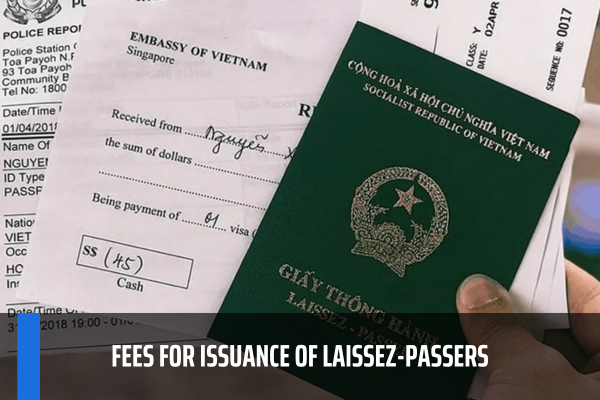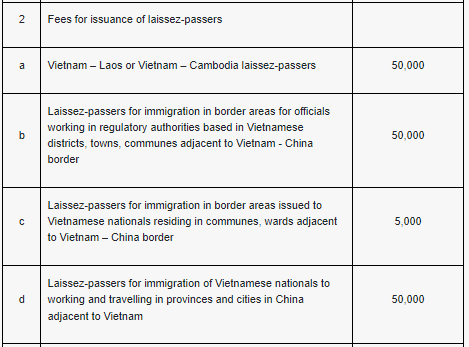To reduce 20% fees for issuance of laissez-passers in Vietnam according to the regulations in Circular 44/2023/TT-BTC?
- What are the laissez-passers? Who are eligible entities to be granted laissez-passers in Vietnam?
- To reduce 20% fees for issuance of laissez-passers in Vietnam from July 1, 2023?
- When will the fees for issuance of laissez-passers in Vietnam be reduced?
- How long is the validity of laissez-passers in Vietnam?
What are the laissez-passers? Who are eligible entities to be granted laissez-passers in Vietnam?
Currently, the concept of "Laissez-passers" is defined in Clause 5, Article 2 of the Law on Entry and Exit of Vietnamese Citizens 2019 as follows:
“Laissez-passers” refer to documents issued by competent authorities of Vietnam to Vietnamese citizens to enable travel across borders according to international agreements between Vietnam and countries sharing borders.
Accordingly, “Laissez-passers” refer to documents issued by competent authorities of Vietnam to Vietnamese citizens to enable travel across borders according to international agreements between Vietnam and countries sharing borders.
Regarding eligible entities to be granted laissez-passers, Clause 1, Article 4 of Decree 76/2020/ND-CP has specific instructions as follows:
Eligible entities to be granted laissez-passers
1. Eligible entities to be granted Vietnam-Cambodia border laissez-passers include officials and public employees and workers working in agencies, organizations and enterprises based in the provinces that share the border line with Cambodia sent to the opposite border province of Cambodia to work.
2. Eligible entities to be granted Vietnam-Laos border laissez-passers:
a) Vietnamese citizens having permanent residence in the province sharing the border with Laos;
b) Vietnamese citizens without permanent residence registration in provinces sharing the border with Laos but working in agencies, organizations or enterprises based in the province sharing the border with Laos.
3. Eligible entities to be granted exit and entry laissez-passers through Vietnam - China border region:
a) Vietnamese citizens permanently residing in communes, wards or townships adjacent to the Vietnam-China border;
b) Officials working in state agencies based in districts, towns and provincial cities of Vietnam adjacent to the Vietnam-China border who are sent to the opposite border region of China to work.
Thus, the subjects who are granted travel documents in each case include the subjects mentioned above.

To reduce 20% fees for issuance of laissez-passers in Vietnam according to the regulations in Circular 44/2023/TT-BTC?
To reduce 20% fees for issuance of laissez-passers in Vietnam from July 1, 2023?
On June 29, 2023, the Ministry of Finance issued Circular 44/2023/TT-BTC on Fees and charges to support the people and enterprises.
Accordingly, with respect to the fee for issuance of passports, Section 21, Clause 1, Article 1 of Circular 44/2023/TT-BTC stipulates as follows:
Fees and charges to support the people and enterprises
1. From July 1, 2023 to the end of December 31, 2023, regulations on fees and charges are as follows:
...
Thus, according to the above regulations, from July 1, 2023, the fees for issuance of laissez-passers will be reduced by 20%, equal to 80% of the current fee.
Accordingly, referring to the current fee rates in the Schedule on Fees and Charges issued together with Circular 25/2021/TT-BTC as follows:

Thus, from July 1, 2023, the fee for issuance of laissez-passers is calculated as follows:
Cases | Fees for issuance of laissez-passers from July 1, 2023 |
Vietnam – Laos or Vietnam – Cambodia laissez-passers | 40.000 |
Laissez-passers for immigration in border areas for officials working in regulatory authorities based in Vietnamese districts, towns, communes adjacent to Vietnam - China border | 40.000 |
Laissez-passers for immigration in border areas issued to Vietnamese nationals residing in communes, wards adjacent to Vietnam – China border | 4.000 |
Laissez-passers for immigration of Vietnamese nationals to working and travelling in provinces and cities in China adjacent to Vietnam | 40.000 |
Unit: VND
When will the fees for issuance of laissez-passers in Vietnam be reduced?
Pursuant to Article 2 of Circular 44/2023/TT-BTC on implementation effect as follows:
Entry into force
1. This Circular is effective from July 1, 2023 until the end of December 31, 2023.
2. If any legislative document referred to this Circular is amended, supplemented, or replaced, comply with its new edition.
3. Difficulties that arise during the implementation of this Circular shall be promptly reported to the Ministry of Finance for additional study and guidance./.
Accordingly, the fees for issuance of laissez-passers are reduced until December 31, 2023.
After this time, when the regulation on reduction of fees for issuance of laissez-passers expires on December 31, 2023, the fee collection rate from January 1, 2024 will comply with current regulations.
How long is the validity of laissez-passers in Vietnam?
Pursuant to Clause 3, Article 7 of the Law on Exit and Entry of Vietnamese citizens 2019, the validity of laissez-passers is as follows:
Validity of entry and exit documents
1. Diplomatic passports and service passports shall be effective from 1 to 5 years; can be extended no more than 3 years per instance.
2. Validity of regular passports is as follows:
a) Regular passports issued to persons from 14 years of age shall be effective for 10 years and shall not be extended;
b) Regular passports issued to persons under 14 years of age shall be effective for 05 years and shall not be extended;
c) Regular passports issued by shortened procedures shall be effective for no more than 12 months and shall not be extended.
3. Laissez-passers shall be effective for no more than 12 months and shall not be extended.
Based on the above regulations, laissez-passers shall be effective for no more than 12 months and shall not be extended.
When the above time limit expires, a new laissez-passer must be issued; the old laissez-passer and shall not be extended.
Circular 44/2023/TT-BTC takes effect from July 1, 2023 to December 31, 2023.
LawNet
